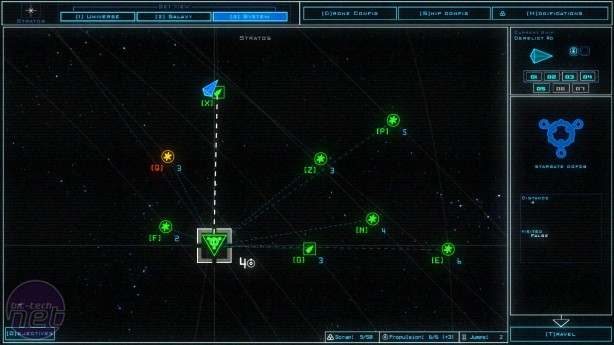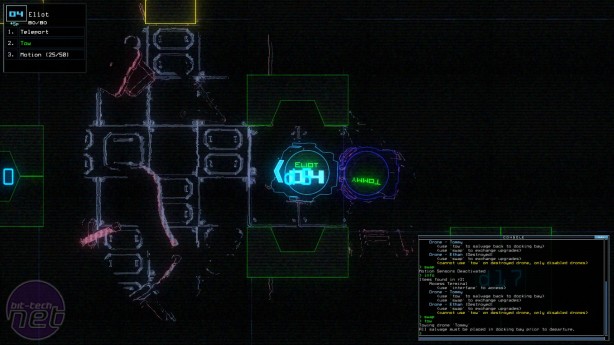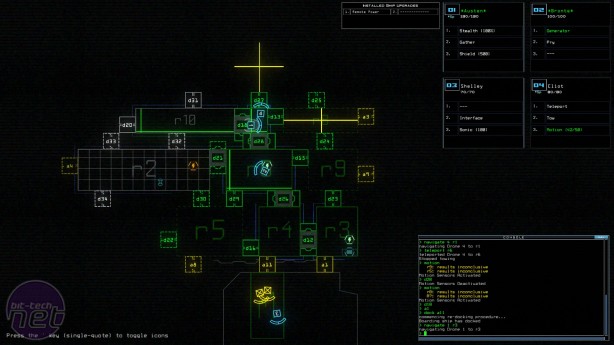
As you’ve probably sussed by now, the debut game by Misfits Attic is a sci-fi survival horror in which you explore a procedurally generated galaxy, raiding derelict ships for supplies and trying to avoid getting your dutiful robot drones devoured by Utterly Awful Aliens. That’s already a pretty neat concept, but what elevates Duskers to another level entirely is how seamlessly it interweaves its theme, its aesthetics, and its mechanics. It’s one of those rare games which I would normally say feel like it was grown rather than made, except for the fact Duskers is so deliciously, deliberately synthetic.
I mean look at it. Just look at it. Look at all those clean lines and flickering green typefaces and schematic-like ship maps and grainy CRT feeds. Duskers is utterly committed to its retro-futuristic depiction of space and interstellar exploration. But Duskers goes further than a depiction of what computers would look like in the late-seventies vision of the future. It bakes its retro-futurism into how the game plays.
Duskers is almost entirely controlled through the command line interface. You can move your drones around the ship manually using the arrow keys, but any specific interactions must be typed in. This may sound onerous, but the required commands are elegantly simple. To gather up scrap, for example, you simply type 'gather' and the drone with the requisite ability will pick it up. If you want to gather all of the items in a room, be they scrap, or all-important fuel for your ship. you type 'gather all'. Even moving drones around a ship or station is straightforward. To move Drone 1 into room 3, for example, you type 'Navigate 1 r3', and that’s it.
The idea behind this is to maximise immersion, to put you in the seat of a lone explorer of a dead galaxy, remotely piloting drones through the dark, creaking corridors of centuries-old spacecraft. Such immersion is vital to making the rest of the game function. See, you might be the last surviving human in the Universe (or ARE you?!?!?!) but you’re certainly not alone. Every ship you encounter has some kind of inhabitant, ominously referred to in the game as 'infestations'. Sometimes you can pinpoint where the infestation is, then use the ship’s security systems to deal with it or simply vent it out of an airlock. But other times, your motion tracker will ping back that terrifying response 'inconclusive', and the only way you can find out for certain if there’s something lurking in there is by sending a drone in to investigate.
That’s the genius of Duskers, the way it revels in uncertainty. The condition of the places you investigate are another prime example of this. If a ship or station is listed 'Stable' you can explore it as cautiously as you like. If it’s 'Volatile', however, that means something will go wrong while you’re exploring, and it’s just a matter of what. It could be, as I already described, that your video feeds go on the fritz. Or it could be that random doors on the ship stop working. Or it could be a radiation leak that will slowly melt your drones. Add to this the fact that your own equipment degrades the more you use it, and the horror stories which can emerge from Duskers’ systems are utterly captivating.
Even when everything runs smoothly, by the time you’ve safely returned your drones to the hangar, your back will be tight from the raw, pulsing tension that Duskers creates. Alongside being a fiendish procedural horror, Duskers is a splendid puzzle game, capable of generating some imposing explorative conundrums as you try to figure out which sequence of doors to open in order to flush out an infested room, but without putting any of your drones in danger, while also maintaining the power in that particular area of the ship.
There’s remarkably little to complain about too. The difficulty of the experience obviously varies depending on how your particular universe generates, and which ships and stations you choose to explore. But such is the nature of roguelikes. The only other issue is that Duskers’ spooky atmosphere evaporates somewhat when the game reveals its hand. Many horror experiences lose something once you’ve seen the monster, but I think Duskers could have done more with its enemy designs, or found further ways to obscure their identity somehow, a-la Amnesia. When you tentatively drive into an infested room only to discover the infestation is a rather janky looking robot it’s a touch deflating.
On the whole though, Duskers maintains its atmosphere superbly, through a careful, exhaustively considered blend of striking visuals and compulsive system design. Even the menu screen gets in on the act, mimicking the green-glowing typeface of a CRT monitor. Burst my chest and call me Kane if you don’t play a more immersive game this year.
I mean look at it. Just look at it. Look at all those clean lines and flickering green typefaces and schematic-like ship maps and grainy CRT feeds. Duskers is utterly committed to its retro-futuristic depiction of space and interstellar exploration. But Duskers goes further than a depiction of what computers would look like in the late-seventies vision of the future. It bakes its retro-futurism into how the game plays.
Duskers is almost entirely controlled through the command line interface. You can move your drones around the ship manually using the arrow keys, but any specific interactions must be typed in. This may sound onerous, but the required commands are elegantly simple. To gather up scrap, for example, you simply type 'gather' and the drone with the requisite ability will pick it up. If you want to gather all of the items in a room, be they scrap, or all-important fuel for your ship. you type 'gather all'. Even moving drones around a ship or station is straightforward. To move Drone 1 into room 3, for example, you type 'Navigate 1 r3', and that’s it.
The idea behind this is to maximise immersion, to put you in the seat of a lone explorer of a dead galaxy, remotely piloting drones through the dark, creaking corridors of centuries-old spacecraft. Such immersion is vital to making the rest of the game function. See, you might be the last surviving human in the Universe (or ARE you?!?!?!) but you’re certainly not alone. Every ship you encounter has some kind of inhabitant, ominously referred to in the game as 'infestations'. Sometimes you can pinpoint where the infestation is, then use the ship’s security systems to deal with it or simply vent it out of an airlock. But other times, your motion tracker will ping back that terrifying response 'inconclusive', and the only way you can find out for certain if there’s something lurking in there is by sending a drone in to investigate.
That’s the genius of Duskers, the way it revels in uncertainty. The condition of the places you investigate are another prime example of this. If a ship or station is listed 'Stable' you can explore it as cautiously as you like. If it’s 'Volatile', however, that means something will go wrong while you’re exploring, and it’s just a matter of what. It could be, as I already described, that your video feeds go on the fritz. Or it could be that random doors on the ship stop working. Or it could be a radiation leak that will slowly melt your drones. Add to this the fact that your own equipment degrades the more you use it, and the horror stories which can emerge from Duskers’ systems are utterly captivating.
Even when everything runs smoothly, by the time you’ve safely returned your drones to the hangar, your back will be tight from the raw, pulsing tension that Duskers creates. Alongside being a fiendish procedural horror, Duskers is a splendid puzzle game, capable of generating some imposing explorative conundrums as you try to figure out which sequence of doors to open in order to flush out an infested room, but without putting any of your drones in danger, while also maintaining the power in that particular area of the ship.
There’s remarkably little to complain about too. The difficulty of the experience obviously varies depending on how your particular universe generates, and which ships and stations you choose to explore. But such is the nature of roguelikes. The only other issue is that Duskers’ spooky atmosphere evaporates somewhat when the game reveals its hand. Many horror experiences lose something once you’ve seen the monster, but I think Duskers could have done more with its enemy designs, or found further ways to obscure their identity somehow, a-la Amnesia. When you tentatively drive into an infested room only to discover the infestation is a rather janky looking robot it’s a touch deflating.
On the whole though, Duskers maintains its atmosphere superbly, through a careful, exhaustively considered blend of striking visuals and compulsive system design. Even the menu screen gets in on the act, mimicking the green-glowing typeface of a CRT monitor. Burst my chest and call me Kane if you don’t play a more immersive game this year.


MSI MPG Velox 100R Chassis Review
October 14 2021 | 15:04













Want to comment? Please log in.